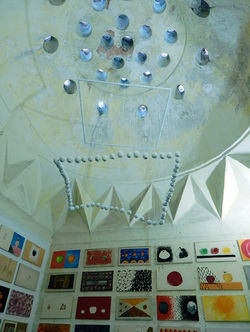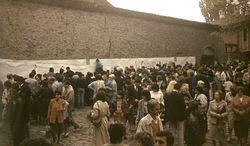The Edge Group is a complete phenomenon that exemplifies the strongest manifestations of Bulgarian conceptualist art at the beginning of the 1990ies. Formed in January 1989, the group is a synthesis of the two main principle used to form artistic groups in the country at the time – the territorial and the conceptual. The artists who founded the group are: Albena Mihaylova, Veneta Marinova, Dancho Grigorov, Dimitar Kelbechev, Dimitar Mitovski, Emil Mirazchiev, Ivaylo Grigorov, Igor Boudnikov, Kolio Karamfilov, Monika Romenska, Nadia Genova, Pavel Albert, and Roumen Zhekov. The larger part of the founding members of the newly established group was already known to the Bulgarian audience with their work in non-conventional idioms.
By establishing the Edge Group the artists were reacting to the crucial political events of the time, but also to the possibility to state clearly their radical position concerning the change in the artistic practices in Bulgaria. Participating artists claimed a strict aesthetic and ideological position that outlined the future development of the group. It was based on clear cut concepts, materialized in new artistic ways, with strong social engagement and adequate creative attitudes towards the political and artistic reality in the country. The unpublished program of the group states clearly that the group refuses to partake in the “mechanized, centralized, ideology-ridden, pseudo-cultural system”. The Edge Group stated that they stand in defense of the new type of communicating the art work, of the new types and genres in art, and of artistic realization, which is “different from the old societal mechanisms and political conformism.” Among the main goals of the group was the meaningful exchange with the international art and the inclusion of Bulgarian artists in the global cultural dynamics. They also stated that while counting on experimentation and uncompromising defense of their ideas, they will build up the image of the group and will affirm it as an active unified organism.
There is another reason for the appearance of this strong regional phenomenon – the fact it came to life in Plovdiv is not a coincidence. The springing forth of the Edge Group in the city precisely at the time of the crucial years of the changes is rooted in the indirect but strong link to that generation of artists from the 1960ies, which left the traces of revolutionary change in the artistic process.
The radical involvement of the April Generation of artists (who came to the fore at the time of softening up of the communist regime after April 1956) in the early 1960ies blew up the burden of the socialist-realist artistic cannon and won the plastic freedoms that opened the doors for socialist modernism. Although that happened only within the confines of traditional media, those artists became the standard bearer of the artistic revolution analogous to the one from the end of the 1980ies. Vastly different in the substance of their artistic search, the two generations were fighting for the qualitatively new functions of the art work – the former stood by the art work as an expression of the autonomous creative process in its formal and aesthetic aspects; the latter, the Edge artists became synonymous with the notion of braking down those formal boundaries at the expense of the autonomy of the idea. Even if we only consider the openly rebellious substance and the revolutionary approaches of the April Generation of artists from Plovdiv we will still see that more than twenty years later, and within the tracks of historical continuity, the city was nurturing the next generation in the spirit of open defense for creative freedom.
At its early stages the Edge defined their conceptual direction and clarity in informal talks where the artists got to know each other. They would find and define their shared views; they would coordinate their world view; they would encourage each other in inspiration and daring; they would plan and debate their ideas. The members of the group felt their strong ideological bond based on shared thinking about the change in the artistic structures, about the new functions of the artwork and about the new type of communicating with the viewer brought about by the new situation. The aggression, the irony and playing with the viewers were definitely the main thread in the conceptual direction of the group. Those were also defining to a large extent the visual embodiment of concrete ideas.
The founding and the creative trajectory of Plovdiv’s Edge Group is a stand-alone history within the history of contemporary art in Bulgaria.
 |
|---|
 |
 |
 |
 |
 |
 |
 |
 |
 |
 |